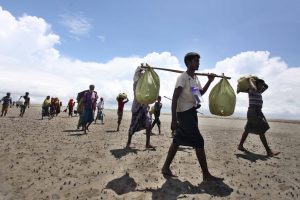More than 200 people protested yesterday in western Indonesia against the continued arrival of Rohingya refugees by boat, claiming that the sudden influx of people threatens to overwhelm local communities.
More than 1,500 Rohingya civilians, seeking to escape the heaving, unsanitary, and crime-ridden refugee camps of southern Bangladesh, have washed up on Indonesia’s shores since last month, most of them in Aceh, on the western tip of Sumatra.
According to The Associated Press, the protest was held in Sabang island, off the western tip of Aceh, where two boats landed carrying hundreds of people, including women and children, on November 21 and December 2.
Most of the protesters were local residents and students, who called on authorities and the U.N. refugee agency UNHCR to remove all Rohingya refugees from the island and for groups like the UNHCR and the International Organization for Migration (IOM) to leave. According to the AP, protesters held signs reading “Kick out UNHCR and IOM” and “UNHCR and its agents, do you really want to trade humanity for money?”
“Our demand is to reject them all,” one protester told the news agency. “They must leave. Because Sabang people are also having a hard time, they cannot accommodate any more people.”
The recent surge of arrivals reflects the deteriorating conditions in the refugee camps of southeastern Bangladesh, where around 1 million mostly Rohingya men, women, and children have languished for years. Most arrived there in August and September of 2017, when the Myanmar military drove more than 700,000 Rohingya civilians from Rakhine State into Bangladesh, in a campaign that a U.N. fact-finding panel claims was marked by “genocidal intent.”
But the influx of arrivals beginning last month, when the monsoon ended and the weather became calm enough for people to brave the perilous ocean voyage from Bangladesh, has simply transferred this burden to Indonesia.
And there is no clear end in sight. Unable to return to their homes in conflict-torn Myanmar, and life in the camps becoming harder due to reductions in food rations and growing gang violence, it is probably that the number of people willing to brave the dangerous sea journeys to Indonesia and Malaysia will only increase in the months and years to come. Indeed, 2023 is already shaping up as the busiest ever year for the numbers fleeing Bangladesh by boat.
According to UNHCR and IOM, there were approximately 1,722 Rohingya refugees in Aceh as of December 12. That number is expected to rise to as many as 2,000 Rohingya by the end of the year and “possibly 3,500 by the end of March 2024.”
Rohingya refugees and asylum seekers have been seeking sanctuary in Aceh for years, seeking to escape both severe persecution in Myanmar and the hardships of life in the Bangladeshi refugee camps.
In previous years, much has been said about the hospitality of the Acehnese toward these foreign arrivals. As I wrote back in 2020, the devoutly Islamic region of western Sumatra “represents an exception to the region’s inhospitable norm.” Partly this was due to Islamic solidarity and partly to the region’s system of customary maritime law, known as Panglima Laot, which obliges Acehnese fishermen to help boats in distress.
However, it turns out that these social norms have their limits: the current wave of boat arrivals has been accompanied by unusual resistance – even hostility – from communities in Aceh. On two occasions last month, villagers in Aceh pushed refugee boats back to sea instead of providing much-needed help to those aboard, who are often starved and exhausted after lengthy ocean journeys. Following the arrival of the boat on Sabang on December 2, people also held protests outside the mayor’s office on the island.
Writing in New Mandala on December 4, Nino Viartasiwi and Antje Missbach noted a number of possible reasons for the apparently sudden negative turn of Acehnese against the Rohingya. In addition to the simple question of numbers, they mentioned social media publicity, perceptions of a lack of gratitude for past aid, possible insults and cultural misunderstandings, and the alleged involvement of Acehnese villagers in “smuggling” Rohingya to Indonesia as possible factors.
Less relevant perhaps than the cause is the result. According to Viartasiwi and Missbach, “the villagers’ rejection of the recent arrivals and depiction of these events in the media are being used to support the Indonesian authorities’ increasingly hostile position opposing the arrival of more Rohingya in Indonesia.”
In mid-November, the Ministry of Foreign Affairs stated that Indonesia, which is not a signatory of the 1951 Refugee Convention, has no obligation nor capacity to accommodate refugees, let alone to provide permanent solution. A ministry spokesperson added that the country’s “kindness in providing temporary shelter has been misused by people smugglers.”
Indonesia’s government has begun considering more permanent solutions for the mounting refugee crisis in Aceh, with one senior official mulling the possible reopening of the refugee camp on Galang Island. Located in the Riau Archipelago close to Indonesia’s maritime border with Singapore, Galang was active from 1975 to 1996 and accommodated around a quarter of a million refugees from Vietnam and other parts of Indochina.
At the same time, under increasing domestic pressure, it has also called on the wider world for assistance with the growing refugee burden.
“We see that the handling of the refugee problem, especially the resettlement issue, has been very slow so far,” Foreign Ministry spokesperson Muhammad Iqbal told a news conference in Jakarta, the AP reported. He urged the international community to “show more responsibility in efforts to resolve the Rohingya refugee problem.”
Given that six years have now elapsed since most of the Rohingya refugees were driven out of their homes, bringing annual calls for renewed attention toward the plight of a people whom a U.N. official described in 2009 as “probably the most friendless people in the world,” it is very likely that Indonesia will have to find its own solutions to Asia’s never-ending refugee crisis.

































